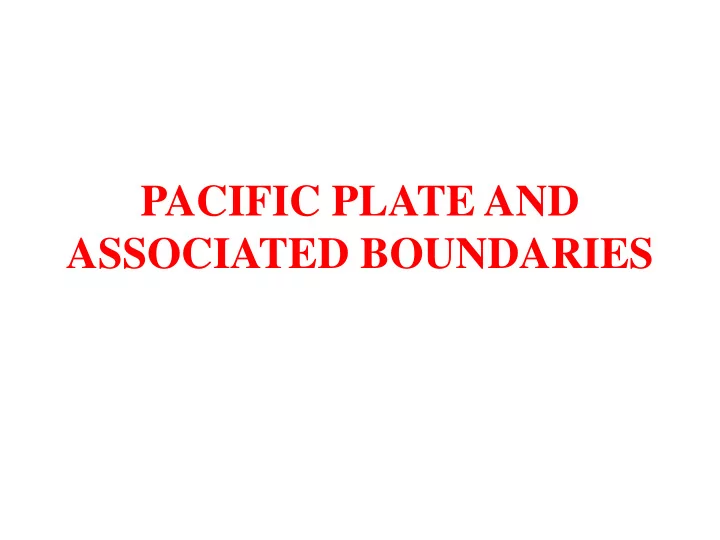

PACIFIC PLATE AND ASSOCIATED BOUNDARIES
The Pacific Plate • Pacific Plate is the largest plate and an oceanic plate. • It shares its boundaries with numerous plates namely; North American Plate.(Convergent and transform fault) Philippine Plate.(Convergent) Juan de Fuca Plate.(Convergent) Indo – Australian Plate.(Convergent, Transform Fault) Cocos Plate.(Divergent) Nazca Plate.(Divergent) Antarctic Plate.(Divergent,Transform Fault)
Types of Plate Boundaries • Convergent Boundary: Subduction zones where two plates converges. Eg; Aleutian Islands(Alaska) • Divergent Boundary: Spreading centres where two plates move away from each other. Eg; East Pacific Rise (MOR, Pacific Ocean). • Transform Faults: Boundary where two plates slide past each other. For Eg. ; San Andreas Fault.
BOUNDARY WITH ANTARCTIC PLATE DIVERGENT BOUNDARY • Pacific – Antarctic Ridge TRANSFORM FAULT • Louisville Seamount Chain
Pacific – Antarctic Ridge Pacific – Antarctic Ridge(PAR) is located on the seafloor of the South Pacific Ocean. It is driven by the interaction of a mid oceanic ridge and deep mantle plumes located in the eastern portion of East Pacific Ridge.
Louisville Seamount Chain It is the longest line of seamount chain in the Pacific Ocean of about 4,300 km, formed along the transform boundary in the western side between Pacific plate and Antarctic plate. It was formed from the Pacific Plate sliding over a long – lived centre of upwelling magma called the Louisville hotspot.
BOUNDARY WITH PHILIPPINE PLATE CONVERGENT BOUNDARY • Izu – Ogasawara Trench • Mariana Trench
Izu – Ogasawara Trench It is an oceanic trench in the western Pacific Ocean. It stretches from Japan to northern most section of Mariana Trench. Here, the Pacific Plate is being subducted beneath the Philippine Sea Plate.
Mariana Trench It is part of the Izu – Bonin – Mariana subduction system. In this system, the western edge of Pacific Plate is subducted beneath the Philippine Plate leading to formation of this long, narrow deep – sea trench. In the Mariana Trench, the ocean reaches its greatest depth, about 11 km.
BOUNDARY WITH COCOS AND NAZCA PLATE DIVERGENT BOUNDARY • East – Pacific Rise • Galapagos Rise
East – Pacific Rise This MOR separates the Pacific Plate to the west from the North American, Cocos, Nazca and the Antarctic Plate. The volcanic belt along Andes and the arc of volcanoes through Central America are the direct result of this collision.
Galapagos Rise It is a currently active ridge above which Galapagos Islands have formed. It consists of active shield volcanoes, delineated by large summit calderas and lava plateaus. It has a history of major volcanic eruptions. These Islands are also very rich in bio diversity, having some very rare species.
BOUNDARY WITH INDO – AUSTRALIAN PLATE CONVERGENT BOUNDARY • Puysegur Trench TRANSFORM FAULT • Alpine Fault
Puysegur Trench It is one of the most complex boundaries due to the unique collision of the two plates creating two convergent boundaries separated by a transform boundary. It is formed as the Indo – Australian Plate subducted beneath the Pacific Plate. It then makes contact with the Alpine fault, a transform boundary which makes it unique. Its rate of subduction is approx. 5.5 – 7.4 cm/year.
It is a right – lateral strike – slip fault, Running through out the New Zealand’s South Island. Earthquakes along the fault have formed the Southern Alps. Upliftment of the fault in the south East is due to an element of convergence between the plates. It has very fast average slip rates as compared to global standards, of about 30mm a year.
BOUNDARY WITH NORTH AMERICAN PLATE CONVERGENT BOUNDARY • Aleutian Islands TRANSFORM FAULT • San Andreas Fault • Queen Charlotte Fault
Aleutian Islands Volcanically active Islands, formed by the subduction of Pacific Plate under North American Plate, in the west of Alaska. It is a chain of 14 large volcanic islands and 55 smaller ones. These islands are in the northern part of the Pacific Ring of Fire.
San – Andreas Fault It is a right – lateral strike slip fault extending about 1300 km through California. It divides into three segments – northern, central and southern. Each with different characteristic and different degree of Earthquake risk
The Pacific Plate to the west of fault is moving in northwest while the North American Plate towards southwest, but relatively southeast under the influence of the plate tectonics. This motion create compressional forces along the eastern side of the fault known as Coast Range.
Queen – Charlotte Fault It is considered as Canada’s equivalent of San – Andreas fault. It has been focus of large earthquakes.
The Pacific Ring of Fire
It is an area in the Pacific Ocean Basin where a large number of earthquakes and volcanic eruptions occur. In a 40,000 km horseshoe shape, it is associated with a continuous series of oceanic trenches, volcanic arcs, volcanic belts and plate movement. About 90% of the world’s earthquakes and 81% of largest earthquakes occur along this.
Recommend
More recommend